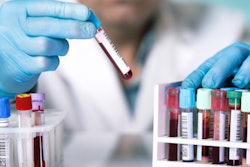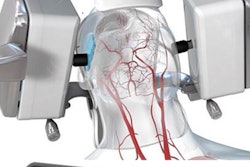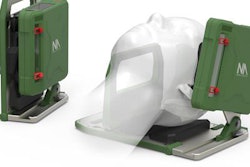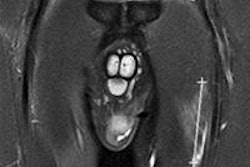
What if you could test rattled athletes for concussion right on the sidelines, simply by having them don a headset outfitted with transcranial Doppler ultrasound probes? California researchers believe this could become a reality and will present their work at next week's American Academy of Neurology (AAN) meeting in Vancouver, British Columbia, Canada.
In a study involving more than 200 high school athletes, a team led by Robert Hamilton, PhD, of brain health technology start-up Neural Analytics found that its technology -- which combines transcranial Doppler ultrasound in a headset with machine-learning software -- generated promising results for differentiating between concussed patients and healthy subjects.
Although the technology is still in the research phase, its developers believe that the specially outfitted headsets could potentially be deployed on sidelines to provide fast assessment of potential concussion in athletes. After a concussion has been diagnosed, the headsets could also help physicians determine when patients can return to competition or their everyday life.
"[These decisions] would be based now on physiology, and not just subjective thinking," said Hamilton, co-founder and chief science officer at Neural Analytics, which was formed to commercialize technology developed at the University of California, Los Angeles. He will present the study next week at AAN 2016.
Assessing concussion
Diagnosing and managing concussions can be challenging, as it often relies on subjective symptom evaluation based on physiological changes. While quantifiable cerebral blood-flow changes have been shown to occur following concussion, this information has previously been available only through functional MRI or MRI with an arterial spin labeling (ASL) sequence, Hamilton said.
 Robert Hamilton, PhD, from Neural Analytics.
Robert Hamilton, PhD, from Neural Analytics."MRI has done an excellent job at assessing blood flow and blood-flow regulation, but there are inherent limitations in MRI [involving its] portability, timing, and spatial resolution," he said. "We wanted to develop a technology that would give clinicians the ability to measure subtle variations in blood flow outside of the hospital setting. We're starting with concussion, but the ultimate vision is to address really any neurological condition with blood-flow alterations, including stroke, dementia, depression, and so on."
Transcranial Doppler (TCD) ultrasound technology has been proposed as a surrogate measure of cerebral blood flow that is low-cost and portable. But conventional cerebral blood-flow velocity waveform metrics such as mean velocity, pulsatility index, and cerebrovascular reactivity index have shown limited diagnostic utility, according to the researchers.
Available since the mid-1980s, transcranial Doppler has been traditionally employed in major injuries such as stroke and severe traumatic brain injuries, Hamilton said.
"Unfortunately, it's been severely underutilized," he said.
Most TCD scans are currently used by neurologists and radiologists only to calculate mean velocity -- how quickly blood is moving through an artery.
"But if you actually look at the waveform, there's an incredible amount of information in the pulsatile features of the morphology of that waveform that is [currently] ignored," he said. "Our machine-learning platform captures that information and gives the clinician additional information about how the blood flow is being regulated. ... This is something that has been there all along, but it's just unfortunately been ignored."
Going beyond just calculating average blood-flow velocity, the Neural Analytics software analyzes the entire TCD waveform signal to track morphological changes between every heartbeat; this provides information to clinicians about the health of vasculature, Hamilton said. The software then calculates what the researchers call a hemodynamic index; a reading above 0.5 indicates dysfunction (i.e., the blood-flow regulation in the brain is abnormal).
Testing
To test their technology, they used the headset to perform transcranial Doppler scans on a group of 66 high school athletes who played contact sports and were recently diagnosed with concussion. The scans were performed within an average of 6.2 days after the initial diagnosis of concussion was made by the treating physician based on neurocognitive and symptom evaluation.
They also gave TCD scans to an age-matched control group of 169 healthy subjects that included high school athletes from both contact and noncontact sports. For the study, contact sports were considered to include football, soccer, basketball, hockey, water polo, and lacrosse; noncontact sports included cheerleading, cross country, cycling, tennis, and track. Approximately 30% of both study cohorts were female.
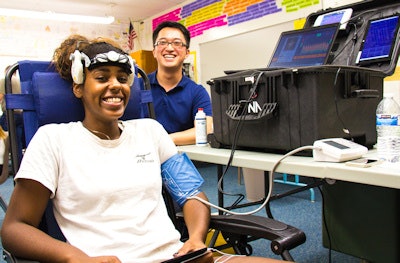 Testing of the TCD ultrasound and machine-learning software in high school athletes showed promising results for diagnosing concussion. Image courtesy of Robert Hamilton, PhD.
Testing of the TCD ultrasound and machine-learning software in high school athletes showed promising results for diagnosing concussion. Image courtesy of Robert Hamilton, PhD.With the participants wearing the headsets and following a cerebrovascular reactivity breath-holding protocol, the team gathered all TCD measurements via bilateral monitoring of the middle cerebral artery. The group also collected arterial blood-pressure, end-tidal CO2, and concussion evaluations.
The researchers then used receiver operator characteristics (ROC) analysis to compare the performance of the conventional TCD metrics to the morphological analysis from the machine-learning algorithm.
Area under the ROC curve ratings in differentiating concussed and healthy groups were as follows:
- Morphological analysis: 83%
- Cerebrovascular reactivity index: 60%
- Mean velocity: 55%
- Pulsatility index: 53%
Morphological analysis yielded 71% sensitivity and 83% specificity.
"Even in mild traumatic brain injury, there is still significant deviation [in cerebral blood-flow regulation] from normal given that population," he said.
Returning to play
In addition to helping to diagnose concussion, the technology could be used by physicians in determining when to allow athletes to return to competition or work.
"This is what our next steps are, to look at how blood flow recovers over time to provide clinicians with tools to make an accurate assessment based on physiologic measures, not just subjective symptoms," Hamilton said. "What we do know from the literature today is that patients may be asymptomatic but still be unable to regulate blood flow efficiently."
Neural Analytics is in the process of collecting data to support an application for U.S. Food and Drug Administration (FDA) clearance, Hamilton said. Two initial validation studies have now been completed on high school athletes with the company's prototype system in the Los Angeles area. Another study, set to begin this fall, will compare the performance of their technology with ASL-MRI and functional MRI in high school athletes.
While the firm is currently using a third-party, FDA-cleared ultrasound system in the headset design, it's in the process of developing its own ultrasound technology, he said. In addition, Neural Analytics has a robotics team that is working on an automated platform to allow transcranial Doppler to be performed by sports trainers, emergency medical technicians, and sports medicine physicians.
"By doing that, we greatly expand the utilization of the technology and put it in the hands of individuals who need to have tools to be able to assess blood-flow changes," Hamilton said.





